Char Dham Hotels and Resorts:
While visiting Char Dhams of Uttarakhand, make sure you book your accommodation in advance during peak season. During lean season, you might get accommodation quite easily, at discount prices as well.
Types of accommodation available in most destinations: Hotels, Resorts, Dharamshala, Lodges, Ashrams, Guesthouses, Tents, Camps, and Homestays
There are number of small and big cities, towns and villages which comes across during entire route of Char Dham Yatra. You can stay at any places which you find good enough as night halt. Make sure the hotels are in good conditions with neat and clean rooms, ventilation, hygenic washrooms and toilets. Some places are remotely located during Char Dham Yatra tour, so be preapred to get average hotels with basic rooms and limited service over there. Also the food options are limited at these destinations.
Hill Stations in Uttarakhand
Dotted with long mountain ranges and glittering jewels in the world map, Uttarakhand is well-known for its glorious hill stations having all the ingredients for perfect love-making holidays. Majestic views of surrounding mountains, snow-capped Himalayas, unpolluted natural charm, meandering slopes, and up-down pathways sided by lush greenery.
Panch Kedar
01 Kedarnath 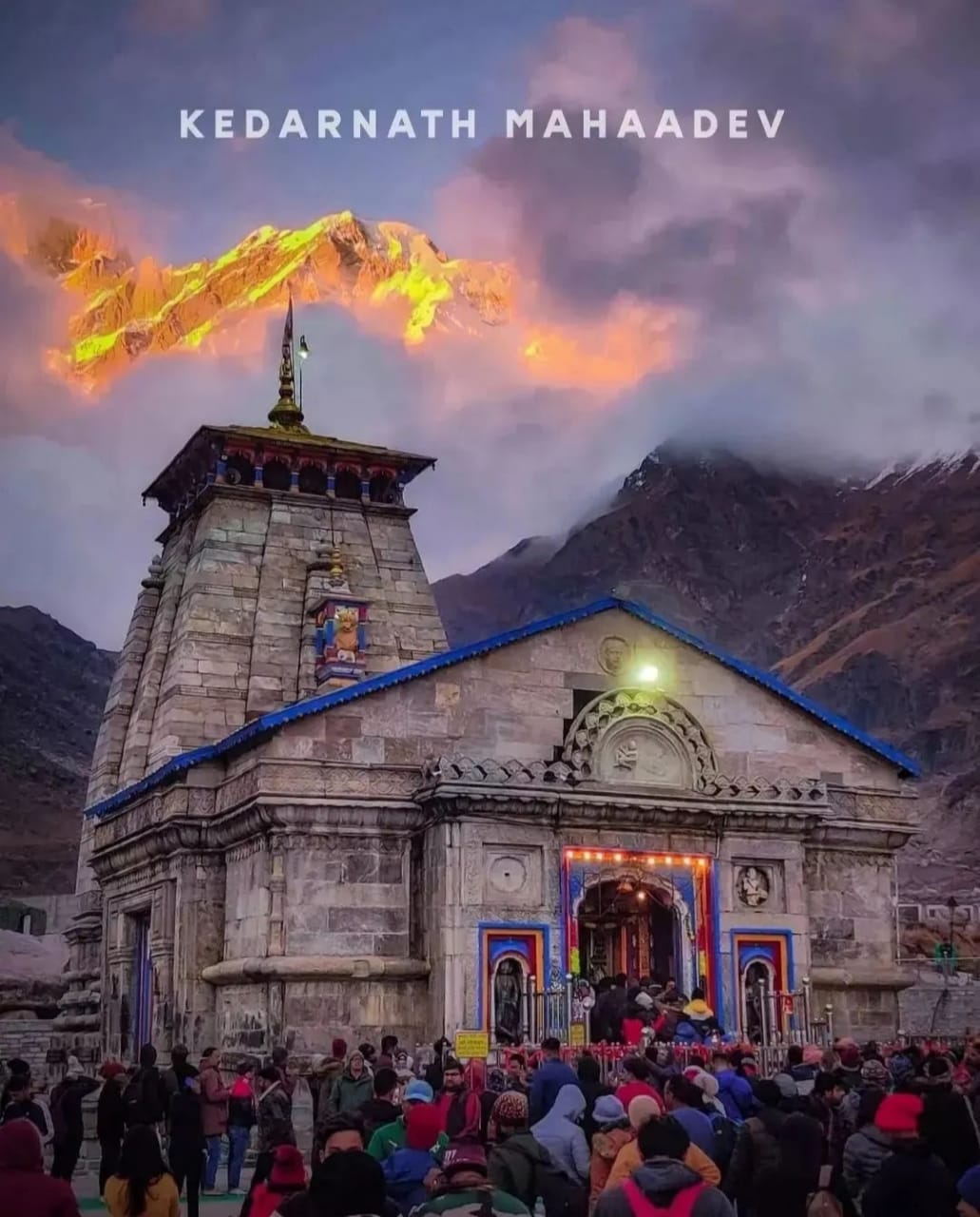
The Kedarnath Mandir (Temple) that nestles at the foothills of the Himalayas is one of the holiest sites of Hinduism. A shrine dedicated to Lord Shiva, the Destroyer of Evil, the temple is one of the 12 Jyotirlingas across India, one of the Char (4) Dhams (Badrinath, Kedarnath, Yamunotri, Gangotri), and one of the 5 Kedars.
Given the treacherous weather in the region, this temple opens to devotees only between the months of April to November each year.
Though there are no inscriptions to go by, it is said that this temple was constructed by a king from the Pandava lineage. His name was Janmajeya. The Shiva Linga here is very ancient.
The temple’s architecture style is said to be the same as most ancient temples of its period – the ashlar style of construction – wherein stone slabs are interlocked into each other without the use of mortar or cement. Each year, thousands of Hindu pilgrims flock to the temple to seek the blessings of Lord Shiva
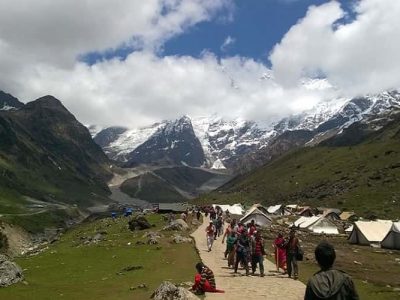
Kedarnath, a popular Hindu temple, tucked away in the lap of Garhwal Himalayas, some 221 km from Rishikesh in Uttarakhand, is one of the twelve Jyotirlinga temples of Lord Shiva. Lying against the backdrop of the magnificent Kedarnath Mandir Range, at an altitude of 3580 meters, the splendid Kedarnath Dham is where the devotees come seeking the blessings of Lord Shiva. Kedarnath Mandir is said to have been constructed by Adi Shankaracharya in the 8th century A.D. The nearby flowing Mandakini River, mesmerizing vistas and splendid sceneries in the form of the snow-clad mountains, rhododendron forests, and salubrious environment make Kedarnath Dham Yatra, a tranquil and picturesque place to be at.
The devotees experience immense peace of mind while undertaking a Kedanath temple spiritual tour. The temple and nature’s milieu is so divine that it always rekindles human beings’ faith in the Almighty. The temple has survived one of the worst flash floods in 2013 of all time in the state, hence enhancing its sacredness and the mystique in the eyes of the devotees. Devotees flock to Kedarnath pilgrimage tour site every year,as a part of Chardham Yatra circuit. Indeed, Kedarnath in Uttarakhand is one of the most prominent pilgrimages, particularly for the Hindus and spiritual seekers.
Best Time to Visit Kedarnath Temple
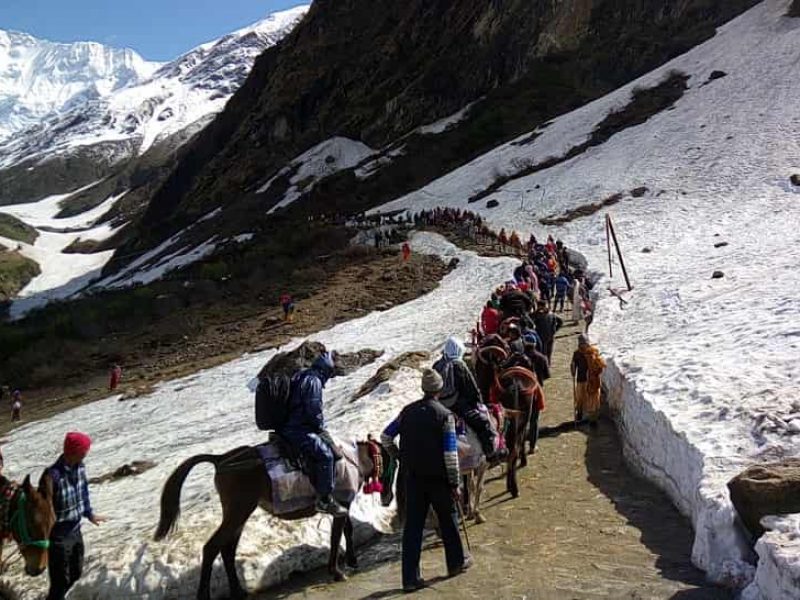
Due to its elevation and geographical location, Kedarnath Temple remains open to the pilgrims for a period of six months. The end of April or beginning of the month of May is chosen for the opening of the portals of this high altitude sacred Hindu shrine. The temple closes right after Diwali and its deity is brought to Ukhimath where its worship continues for next six months of winter. Therefore the best time to visit Kedarnath Dham is between April and November with April to mid-June and October to mid-November being ideal most.
Summer
The month of April marks the beginning of summer season in Uttarakhand. It is the time of the year when the ice melts and with the help of the army, the roads are cleared for the commencement of pilgrimage from April end. The average temperature in Kedarnath during summer ranges from 2℃ to 19℃.
Monsoon
Mid-June marks the commencement of monsoon season in Kedarnath. Even though the temperature touches the mark of 19℃, heavy rains keep it a tad difficult for trekking. Though it has to be noted with right gears and guidance, you can still trek to Kedarnath in monsoon season.
Winter
The portals of Kedarnath close in the winter season that begins right after the day of Diwali. The temperature dips to sub zero and the deity from the temple is brought to Ukhimath to be worshipped for next six months.
Kedarnath by Air
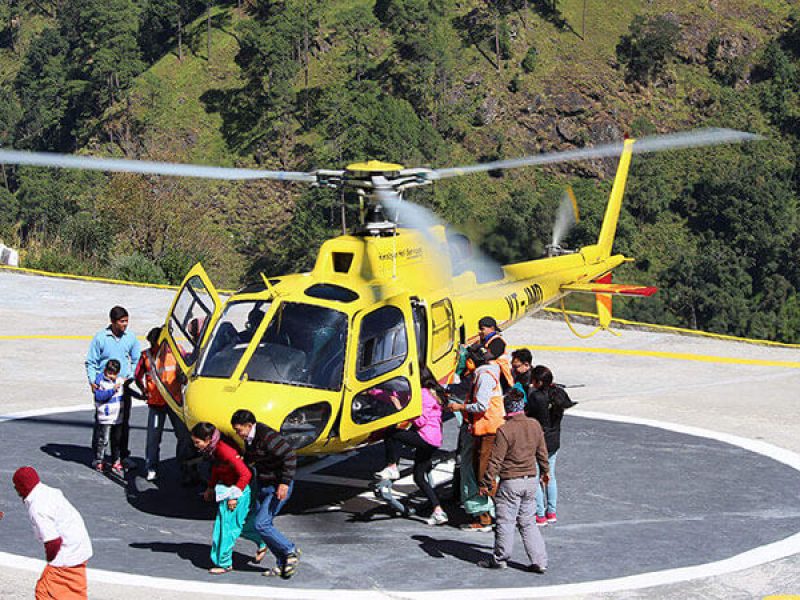
Yes, you can reach Kedarnath by Air also and it is quite comforting too. So, in case you want to skip the tiring trek then you can opt to reach Kedarnath by Air simply by booking a ticket for yourself in a helicopter. Helicopter service is available from Dehradun, Haridwar, and Rishikesh.
From Dehradun: In case you want to take the helicopter service from Dehradun then you have to travel till Shastradhara Helipad in Dehradun and then the helicopter will drop you at your destination in simply 40 minutes.
From Haridwar/ Rishikesh: To take the helicopter service from Haridwar/Rishikesh you need to travel till Phata via taxi and then you can board the helicopter till Kedarnath.
In case you are traveling from other Indian cities, then you need to travel to Jolly Grant airport, Uttarakhand which is the nearest airport to Kedarnath. Booking flights will be comfortable for the longer journeys, especially if you board one from the South of India, and will also help you to save on the travel as many third-party travel sites provide seasonal discounts on flights that you can use. Travel websites like EaseMyTrip provide huge discounts on flight bookings. If you are planning a trip to Kedarnath, you can book it through this travel website. app and save huge money.
Kedarnath is a popular holy destination and it attracts a number of pilgrims to have a holy vocation. So, if you are looking for utter relaxation and serenity, plan your Kedarnath Pilgrimage tour today!
Kedarnath Temple History

The sacred shrine of Kedarnath is said to have been built in the 8th century AD by Adi Shankaracharya at the place adjacent to a spot where the Pandavas of the Mahabharata fame are believed to have constructed a temple. The most popular legend of Kedarnath takes us to the time of Pandavas who after killing their half-brothers, Kauravas in the infamous war were seeking forgiveness from Lord Shiva on the advice of Lord Krishna. It was in Guptkashi that they could spot Lord Shiva who was hiding from them disguised in the form of Nandi, the bull. But one of the Pandavas, Bheema could identify Lord Shiva and chased to only catch him through his tail, while the rest of the body vanished, through a secret cave underneath the ground.
adjacent to a spot where Pandavas of the Mahabharata fame are believed to have constructed a temple. The most popular legend of Kedarnath takes us to the time of Pandavas who after killing their half-brothers, Kauravas in the infamous war were seeking forgiveness from Lord Shiva on the advice of Lord Krishna. It was in Guptkashi that they could spot Lord Shiva who was hiding from them disguised in the form of Nandi, the bull. But one of the Pandavas, Bheema could identify Lord Shiva and chased to only catch him through his tail, while the rest of the body vanished, through a secret cave underneath the ground.
Lord Shiva, who disappeared from Guptkashi reappeared in five different forms namely, hump at Kedarnath, face at Rudranath, arms at Tungnath, navel, and stomach at Madhyamaheshwar and the locks at Kalpeshwar. Another tale about Kedarnath is related to Nar Narayan who went to Badrika Village to worship Parthiva and as a result Lord Shiva appeared before them. Nara-Narayan asked Shiva to remain there in his original form for the welfare of the humanity. Granting their wish, Lord Shiva stayed in that place which is now known as Kedar, thus he is known as Kedareshwara.
Activities around Kedarnath
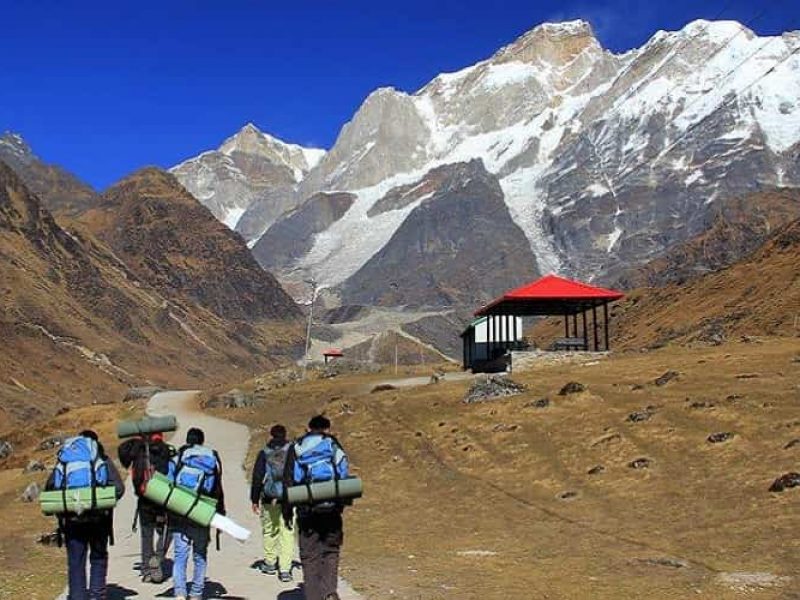
The surroundings of Kedarnath Temple that imbibe the charm and divine aura of the shrine has spectacular attractions on offer. While sightseeing makes the most part of the activities around Kedarnath, there is a fair chance of paying homage to other sacred temples and relishing adrenaline filled trekking expeditions as well.
A dip at Gaurikund
Witnessing the mesmerizing Gandhi Sarovar
Trekking to the high-altitude Vasuki Tal
Paying respect at the Adi Shankaracharya Samadhi
Chopper/Helicopter Ride around Kedarnath
Visiting the sacred Triyuginarayan and Bhairav temples
Top Places to Visit Around Kedarnath
Kedarnath boasts of some picturesque and soul-soothing surroundings which include surreal high altitude lake like Vasuki Tal, the snow-clad mountains, soulful destinations like Ukhimath and Rudraprayag and sacred destinations like Gaurikund. These places come together to weave an aura that must not be missed
Route Locations
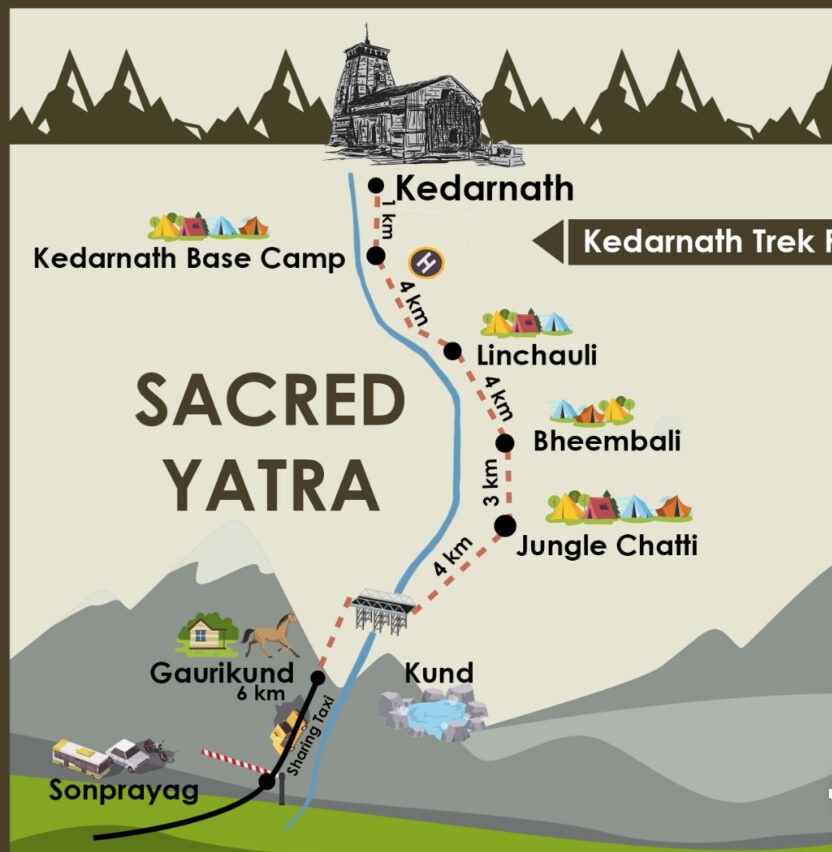
Delhi to Haridwar 206 km –> Haridwar to Rishikesh 24 km –> Rishikesh to Devprayag 74 km –> Devprayag to Srinagar 34 km –> Srinagar to Rudraprayag 33 km –> Rudraprayag to Gaurikund (via Tilwara-Agastmuni-Chandrapuri-Kund-Guptkashi-Phata-Sitapur-SonPrayag) 74 kms –> Gaurikund to Kedarnath (by trek) 14 kms
02 Madmaheshwar :
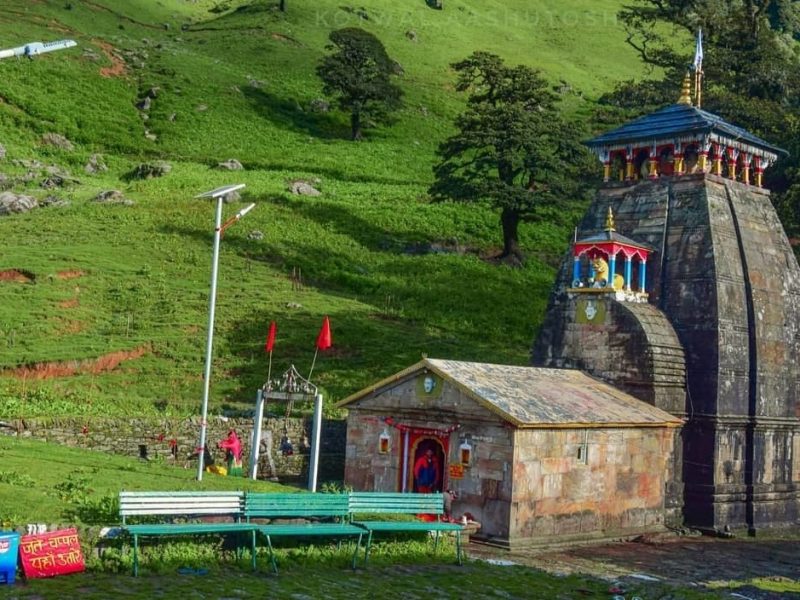
Madhmaheshwar is mystically covered by the snow-capped Himalayas on the right side, lush green alpine meadows on the left side and dense forest act as its backdrop.The shepherd huts, village houses, thousands of years old Madmaheshwar temple and picturesque views complete this town. The temple architecture is a classic north Indian style At a distance of 20 km from Ransi village, 36 km from Ukhimath, 89 km from Kedarnath, Madhyamaheshwar is an ancient Hindu temple located at the base of Chaukhamba peak in the Garhwal region of Rudraprag district in Uttarakhand. Madhyamaheshwar is a beautiful place among the Panch Kedars and is situated at an altitude of 3,497 m.
Madhyamaheshwar temple is dedicated to Lord Shiva. The temple architecture is a classic Nagara style. This is the fourth temple to be visited in the Panch Kedar Pilgrimage circuit; the other temples being Kedarnath, Tungnath, Rudranath and Kalpeshwar. The middle (madhya) or navel of the bull, considered a divine form of Shiva, is worshipped at this temple. There are two other smaller shrines, one for Shiva’s consort Parvati and the other dedicated to the Ardhanarishwara. Bhima, the second Pandava brother is believed to have built this temple and worshipped Shiva here. To the right of the main temple there is a small temple where the marble image of Saraswati is installed in the sanctum.
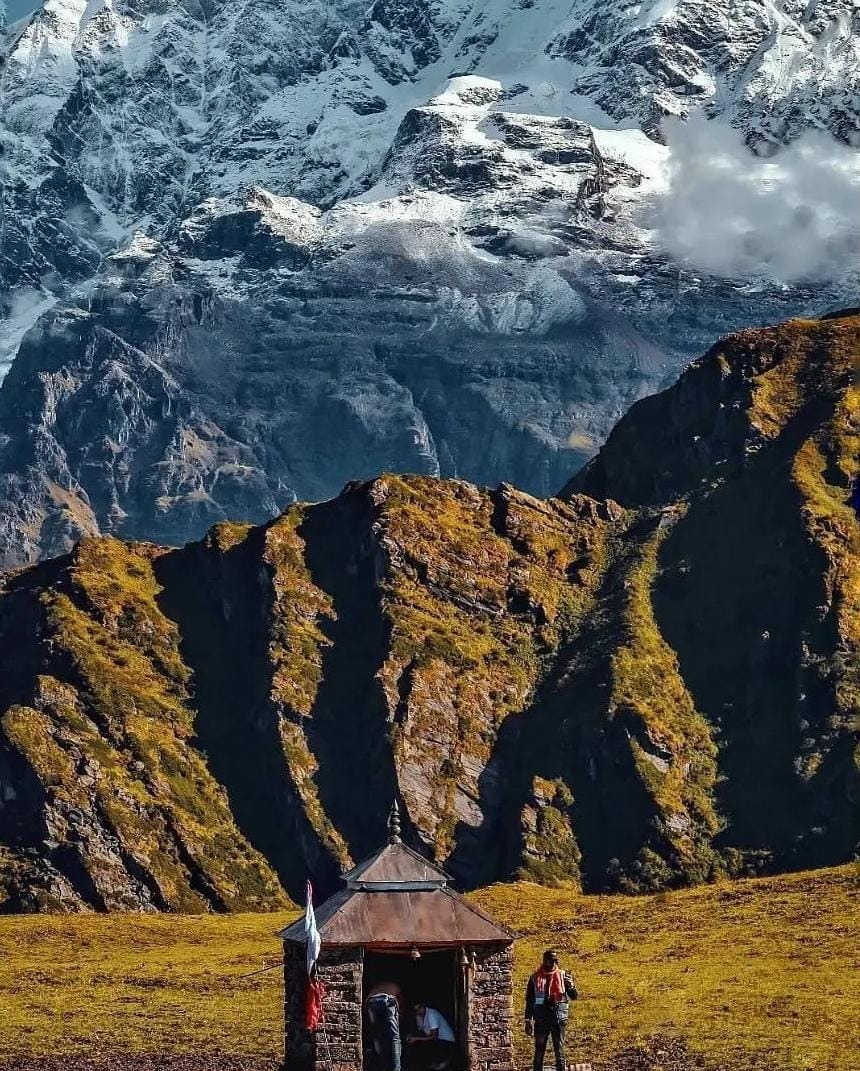
Madhyamaheshwar finds its mention in the Vedas and Mahabharata. As per historians, the land was ruled by the Khasa, Kshatriya and the rulers of Panwar dynasty. Madhyamaheshwar is associated with a legend of war between the Pandavas and Kauravas. In order to absolve from the sin of Gotra Hatya, the Pandavas decided to pay reverence to Lord Shiva. Lord Shiva wanted to avoid them as he was deeply incensed by the death and dishonesty at the Kurukshetra war. Therefore, he disguised in the form of a bull and disappeared into the ground with different parts of the body appearing at various places. Lord Shiva is worshipped in the form of navel – shaped lingam inMadhyamaheshwar.
There is also an old temple known as Vriddh-Madmaheshwar, located on the ridge which looks straight up at the commanding Chaukhamba peaks. Madhyamaheshwar is mystically covered by the snow-capped Himalayas on the right side, lush green alpine meadows on the left side and dense forest as backdrop. Buddha Madhyamaheshwar situated 2 km away from Madmaheshwar another interesting place. Trekking enthusiast can also visit Kanchani Tal situated at a distance of 6 km from Madmaheshwar. Trek to Kanchani Tal is of difficult level. Gaundhar and Kalimath are two important places on the route to Madhyamaheshwar.Uniana village is the last road point from where 19 km trek starts and ends up at Madmaheshwar. The trek is easy up to Bantoli, but from Bantoli to Madmaheshwar there is a steep ascent. After 3 km is Ransi village, a small chatti with a place to stay. The next stretch is 6 km long to Gaundhar where there are 3 lodges to stay. After 1 km, there is Bantoli, the point of confluence of Madhyamaheshwar Ganga and Martyenda Ganga. The trail continues to Khatara, Nanu, and then Madhyamaheshwar. Home stay accommodation options are available at Madmaheshwar.
The best season to visit Madhyamaheshwar is from May to October. The temple remains closed from November to April. During winters, the residing deity is shifted to Ukhimath for worship.
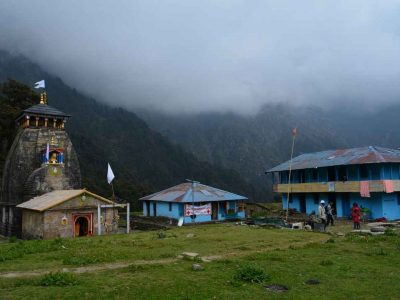
Day 1
Drive from Rishikesh to Ukhimath
You get picked-up with fellow trekkers from Rishikesh railway station or other designated spots by our staff in a cab or bus. After boarding, the drive to Ukhimath takes about 6 to 7 hours.
The drive is replete with serene forest stretches and stunning natural elegance and also passes through the banks of the Ganges River.
The Ukhimath town is a pristine village and also the holy winter home of the idols of Kedarnath and Madmaheshwar temples that are brought down here during winter by the annual Doli-Yatra procession. After reaching Ukhimath, stay overnight in a lodge/hotel or a tent.
Day 2
Ukhimath to Goundar
On the second day of the Madmaheshwar trek package, the trek starts early in the morning after having breakfast. The trek is easy from Ukhimath and you need to do some gradual hike through a few quaint villages like Ranshi.
This trail from Ukhimath to Goundar village is well-paved and passes through the forest full of rhododendrons, oaks, pines, and maple trees. The area houses several beautiful birds and a few wild animals as well. After a few hours of an easy hike, you reach your next halt and stay overnight in a hotel, or lodge, or tent.
Day 3
Goundar to Madhyamaheshwar
Today’s trek takes you to the summit of this Madmaheshwar trek package, which offers not only pristine views but has a spiritual connection as well. The trek starts from Goundar village that is gradual in the starting but becomes a bit steep yet moderate later on. This well-paved trail passes through dense forests to small villages and amazes you with the stunning elegance of lush greens and rustic lifestyle.
After trekking for 1 km from Gaundhar, you witness the unmatched beauty of the Madmaheshwar Ganga, dense forests, and reach the small Bantoli village. Here, you discover the confluence of Mourkhanda River coming from Chaukhamba, and River Madmaheshwari descending from Nandikund, known as the Madmaheshwar Ganga. The trail runs through this verdant Bantoli village and, afterward, a continuous ascent takes to upper-Bantoli. Now an arduous trek takes to the final destination of the Madmaheshwar Valley, where the famous holy shrine is on the left.
The mountain at the backdrop of the temple is the Buda-Madmaheshwar peak where you can reach after a difficult trek of 2 km in 2 hrs. The views of the surrounding mountains through this difficult terrain are extraordinary and enforce the trekkers to visit the place again and again. The Buda-Madmaheshwar has four stunning pools that reflect the unparalleled images of the surrounding mountain ranges. You get back to Madmaheshwar Valley before the dark and stay overnight in a tent or the temple’s Dharamshala.
Day 4
Madhyamaheshwar to Goundar
Wake up with an extraordinary sunrise and enjoy your healthy breakfast to start your return journey to Goundar. Endure the beauty and spiritual values of this pristine Madmaheshwar region, the summit of this Madmaheshwar trek package, and walk for 10 km to reach the basecamp. The trail for the descend is the same as above and is full of nature and wildlife.
Keep your camera ready and capture shots of some of the rare birds you spot and also click pictures of streams, falls, and lush landscapes that you spot through the trail. After a descent of 10 km, you reach Gaundar village, where you have plenty of time to interact with villagers and discover what’s nearby. After having dinner, stay overnight in a tent or a hotel.
Day 5
Goundar to Ukhimath
The fifth day of the Madmaheshwar trek package starts with breakfast and takes you back to the Ukhimath village. The trail is well-paved and easy to trek and is the same that was followed during the ascent. It takes almost three hours to reach back to the beautiful and quaint Ukhimath, which is a popular holy shrine.
After resting for a while and refueling yourself with lunch and tea, you can go for some sightseeing, a village tour, or visit the nearby holy temples. Interact with villagers to learn about their lifestyle or mythological significance that this town possesses. After dinner, rest in your cozy room or tent and enjoy an overnight relaxing sleep.
Day 6
Ukhimath to Rishikesh
Have your breakfast and get ready to bid farewell to this pristine destination. Our vehicle picks you from your hotel or tent and takes you to Rishikesh, the starting point of this Madmaheshwar trek package. Get dropped at the railway station or bus depot or the place of your choice and board your booked train or bus to your home destination.
Madmaheshwar Trek FAQs
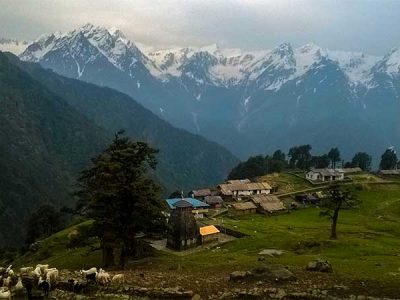
1 .How do I get to Madmaheshwar?
Madmaheshwar lies in the Kedarnath Wildlife Sanctuary in Uttarakhand and to reach there, you have to first reach Ukhimath and then the starting point of the trek, Ransi.
The distance from Rishikesh to Ukhimath to Ransi village can be covered by road while from Ransi, the distance of 16 km to Madmaheshwar Valley requires trekking through well-paved trails or cover the distance on ponies. The Madmaheshwar trek follows a specified route that starts from Ukhimath and passes from Uniyana, Ransi Village (3 km), Gaundar (6 km), Bantoli (1 km), Khatara, Nanu, to Madhyamaheswar.
2. What are the must things to carry before going to Madmaheshwar for trekking?
Things to carry with you while going on for Madmaheshwar trekking are:
o Backpack with rain cover
o 2 bottles of water of 1 liter each
o Energy bars, dry fruits, and electoral/ORS
o Head Torch
o Personal medication, if any
o Comfortable cotton t-shirts and fleece t-shirt as well
o Track pants
o Waterproof jacket
o Sunscreen cream, Hand sanitizer, Moisturizer, Antibacterial Powder, Toilet Paper & Wipes, Toothbrush, Toothpaste, Lip
o Balm, and Quick-dry Towel
o Sunglasses, Cap, Gloves
o Trekking shoes
o A pair of floaters
o First Aid Kit
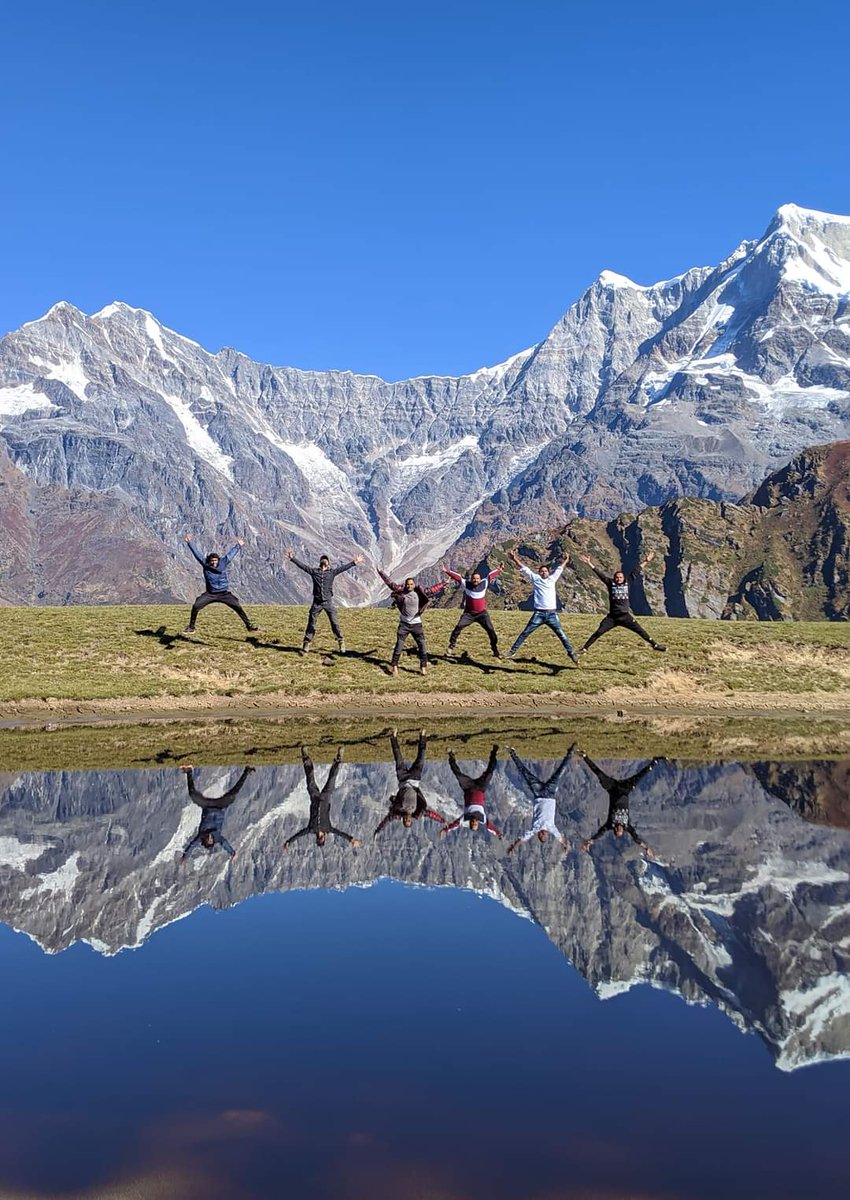
3. What is the best time to visit Madmaheshwar for trekking?
The best time to go for Madmaheshwar trekking falls in May, June, September, October for the best climatic conditions and serene ambiance. July and August months are avoided for the rainy season as the trek becomes slippery. However, during winters, the temple remains closed, and the temperature falls to sub-zero levels.
4. How long is the Madmaheshwar trek?
The total distance of Madmaheshwar trek from Ukhimath to Madmaheshwar Valley is about 32 km, which is complete with serene natural beauty, thick forests, exotic birds, and diverse wildlife. The trek also crosses several small villages and is full of excitement and thrills.
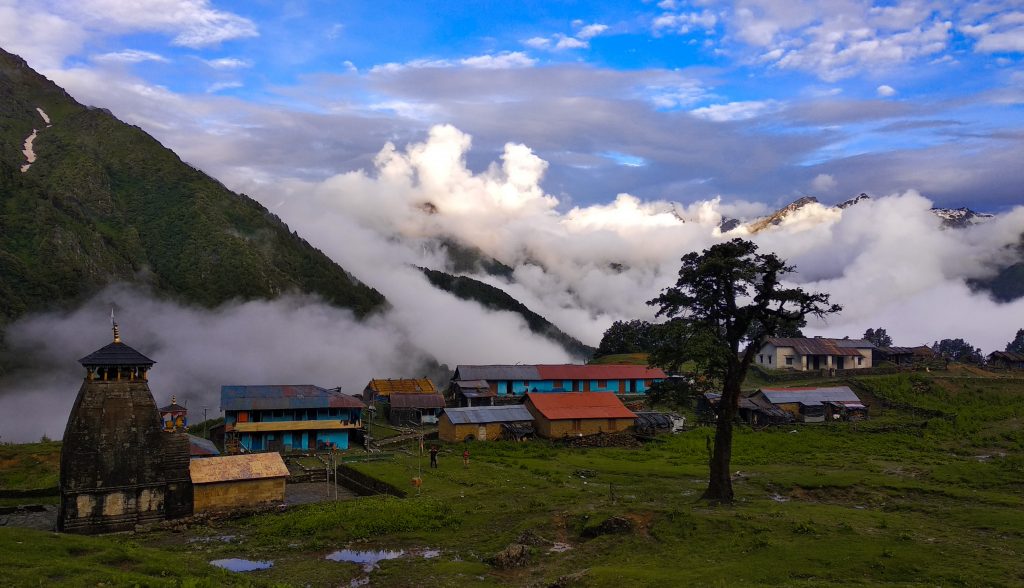
5. Is Madmaheshwar trek safe?
Yes, the Madmaheshwar Trek is safe as it lets you touch the altitude of 11,410 ft. while AMS like altitude sickness starts after reaching the altitude of 14,000 ft or more. The trails are also well-paved and offer easy to moderate difficulty levels. So, if you are fit enough, you can opt for the Madmaheshwar trek package and enjoy a remarkable experience.
6. What is Madmaheshwar famous for?
Madmaheshwar is famous for its Hindu holy shrine Madmaheshwar temple, which is also one of the Panch Kedar. The place is frequented by hindu devotees to offer prayer and seek blessings from Lord Shiva. The trek lies in the Kedarnath Wildlife Sanctuary, which is home to several wild animals like the endangered Himalayan Musk Deer and many beautiful birds. The trek offers diverse varieties of flowers, plants, and trees and also provides stunning views of Himalayan ranges.
03 Tungnath:

Tungnath temple has been found be the highest Shiva temple of the World and is also the highest among the five Panch Kedar temples. It is located in the Indian State of Uttarakhand in the Mountain range of Tunganath in Rudraprayag district. The word Tunganath literally means the God of Mountain. This temple is the highest shrine of Hindus dedicated to Lord Shiva and is located just below Chandrashila’s peak. It is believed to be 1000 years old and in the order of Panch Krdars, it is the tritiya Kedar. The temple has a great connection with the Mahabharata heroes Pandavas.The Tunganatha temple has to offer something to everyone, be it an ardent devotee of the Lord Shiva or a nature lover or is somebody who loves adventurous things. The location of the temple is so that it fabulously adorns the scene of the nature. Scriptures reveal that it is the Tungnatha temple where Lord Shiva’s hands came into rest. And, also it is known that the temple was built by Pandvas to appease Lord Shiva.Along with having great spiritual value, the temple is so beautifully located that it has the power to fascinate the visitors with its idyllic beauty. This is a great place for the ardent trekkers and the place reveals the unmatched beauty of the Gharwal countryside. The pleasantly beautiful and gushing cascade looks as if; it had just appeared from the heaven directly.
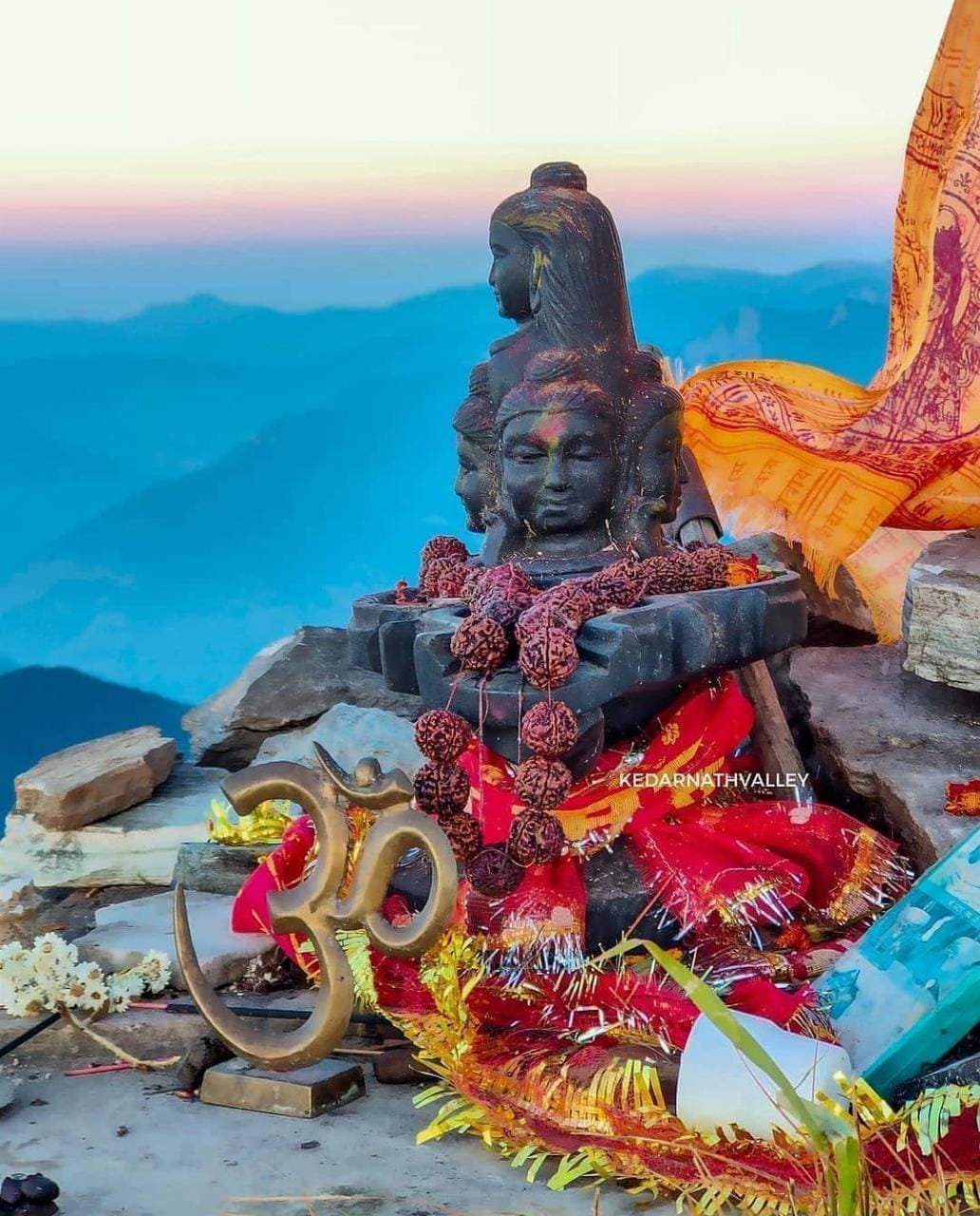
Although, the trekking route of the temple is covered with brown stones, but the fantabulous view of the pasture makes trekking an awe-inspiring experience for peopleAs per the Hindu mythology, both Shiva and his better half Paravati resided in the Himalayas! The Tungnatha temple is actually associated with the Panch Kedar temples which were built by Pandavas. It is believed that Pandavas were advised by sage Vyas Rashi, that their sin of slaying their own cousins Kauravas during the war of Mahabharata in the Kurukshetra, can only be pardoned if they will worship Lord Shiva and make him happy. And, upon the advice they went on to searching for Lord Shiva who was trying to avoid Pandavas because of being convinced about the guilt of Pandavas. In order that, Panvas could not find them, Lord Shiva went on to take a shelter at Guptakashi and took the form of a bull. Nevertheless, Pandavas got catch of him and the body parts of Lord Shiva in the form of bull got rematerialized at five different locations and were later known as Panch Kedaras where the Pndvas built temple of Lord Shiva so as to seek his pardon for their sin to slay their own cousins. Tunganatha was the place where the hands were found! It was Kedarnatha where the hump was seen and the head, navel, stomach and his Jata appeared at Rudranath, Madhyamaheshwar and Kalpeshwara respectively. The facts also say that the chief character of Ramayana, Lord Rama, meditated at Chandrashil peak in the vicinity of Tunganatha. Also, it is believed that the Lanka King Ravana, did Penance to Lord Shivaat the time when he resided there.
Chopta Tungnath Trek Quick Facts:
Tungnath Trek Temperature: Day: 8°C to 15°C and Night: -5°C to 3°C
Maximum altitude: 11,154 ft.
Chopta to Tungnath Trek Distance: 5 Km
Base Camp: Sari Village (6-hour drive from Haridwar)
ATM: Last ATM is in Ukhimath, around 13 KM before Sari
Tungnath: Trek To The Highest Temple Of Lord Shiva
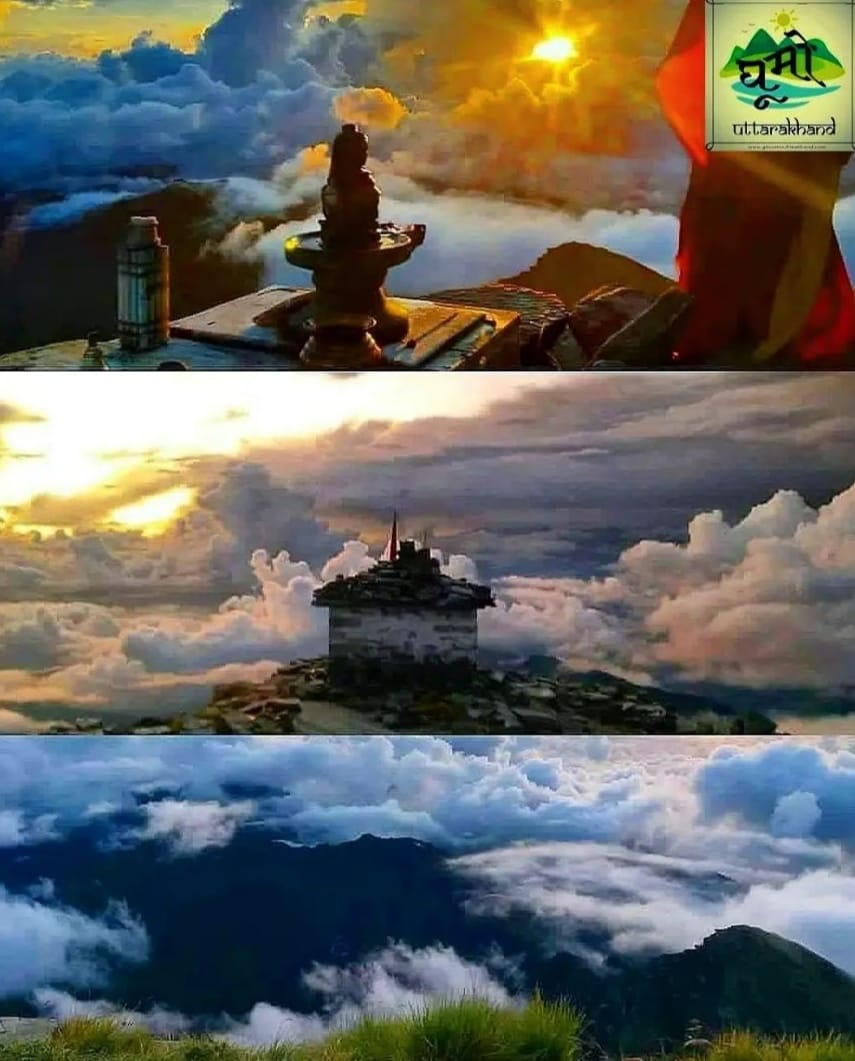
How about a peek-a-boo to one of the oldest and highest Shiva temples in the world?
The thought itself brings such a surge of overwhelming emotions, isn’t it?
Tungnath Temple has perched on the Chandrashila Parvat in the Tungnath mountain range, in the state of Uttarakhand. It sits atop an intimidating altitude of 12,073 feet.
Tungnath Temple is a heavenly abode that literally translates to “God of Mountain Before. Set amidst the most beautiful backdrop, it is not only the highest temple of Lord Shiva but also the highest of the PanchKedar temples.
We will discover more about this magnificent place of worship, first, let us quickly learn about the Panch Kedar temples.
These 5 temples (PanchKedar) are the holy places dedicated to Lord Shiva and therefore, held in high esteem by Hindus for pilgrimage.
The strict order that one should follow for a pilgrimage to these temples is Kedarnath, Tungnath, Rudranath, Madhyamaheshwar, and Kalpeshwar.
Tungnath is the Tritiya Kedar (3rd) among the PanchKedars.
Starting point of Tungnath: Chopta
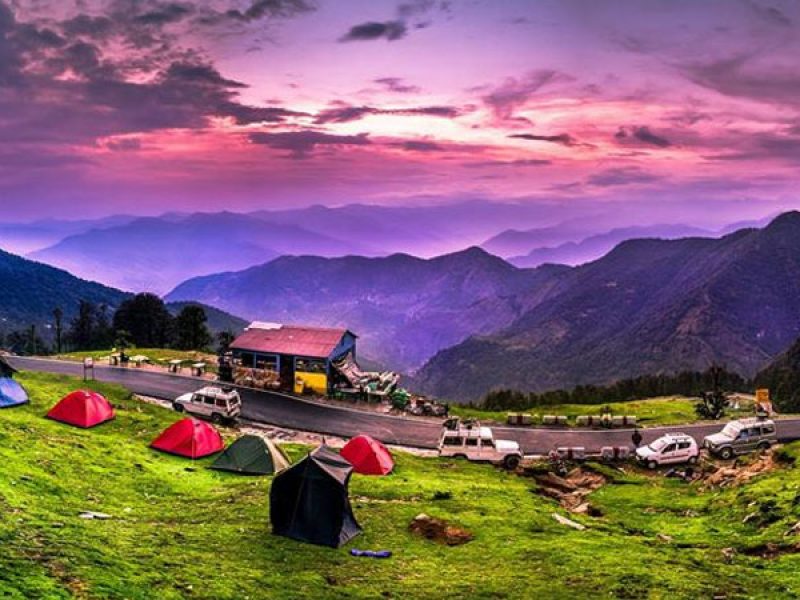
The beautiful meadow of Chopta is perched at an elevation of 8,556 ft in the lush evergreen forest area of the Kedarnath Wildlife Sanctuary. It is a small region that lays 29 km from Ukhimath. Chopta village, also famously known as the “Mini Switzerland of Uttarakhand” is the unspoiled hamlet in the Uttarakhand Himalayas with the mesmerizing view of the majestic peaks such as Trishul, Chaukhamba, and Nanda Devi that leave you awestruck.
Chopta village is blessed with the nature all around it, be it the forest of pine, deodar, and rhododendron or the chirping of the rare bird species to the animals from the wildlife sanctuary. Chopta will leave you mesmerized with its beauty.
Isn’t it ironic that the trek to the highest Shiva temple in the world is short and moderately easy? The trekking route starts at Panger village and journeys to Chopta, the base camp of the trek. This simple yet adventurous trek of 5 km (from Chopta to Tungnath) is dotted with a mixed terrain against the backdrop of distinct Himalayan peaks.
About Tungnath Temple
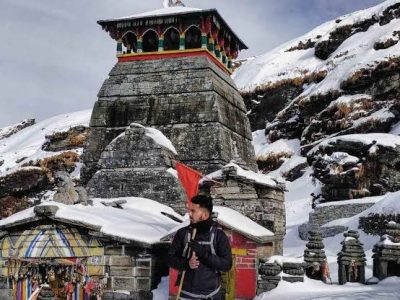
Tungnath temple, also known as Tunganth Mahadev is believed to be more than 1000 years old. It is said that the temple was discovered by Adi Shankaracharya. The temple is the abode of Lord Shiva and houses his beautiful idol. The idols of Goddess Parvati and many other Gods are also located in close proximity to this temple. Owning to harsh winters, the idol of Lord Shiva is moved to his nearby winter abode, Mukkumath Temple during the winter season.
The artistic architecture of Tungnath temple and its bewitching location attract hordes of tourists to this majestic abode of God.
Tungnath temple is best visited along with the Chopta-Chandrashila trek that also covers the high-altitude glacial lake called Deoria Tal.
Tungnath Summit: Chandrashila Peak
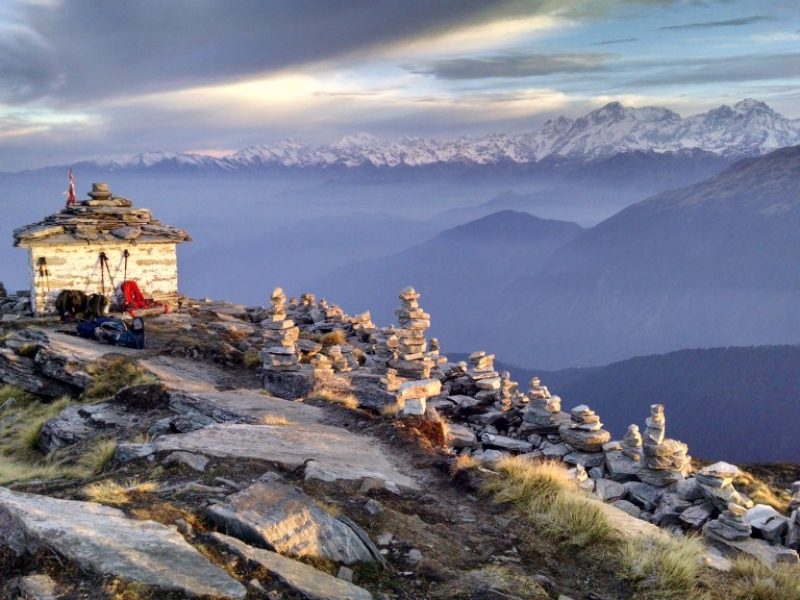
Chandrashila meaning the “moonrock” is the summit or the endpoint for the Tungnath Mahadev Trek. Chandrashila peak is at the alluring height of 13,000 ft above the sea level. Chandrashila has many legends associated with it. According to one legend, Lord Rama after defeating Ravana meditated at this peak. It is also believed that Lakshman, younger brother of Lord Rama meditated here at the Chandrashila Temple.
Another legend that makes Chandrashila peak such a unique destination is, Chandra, the god of the moon stayed here in self-abasement.
The trek route to Chopta Chandrashila trek journeys through lush meadows, quaint hamlets, and thickets of forests to reach the spellbinding temple. The trek moves further to Chandrashila Peak; it takes a steep hike of 1.5 km from Tungnath to reach Chandrashila peak.
The highlights are of the trek are Chopta village, Sari villages, Tungnath Temple, Chandarshila Peak, and Deoria Tal Lake.
While Chopta-Chandrashila trek can be an exciting all-year-round experience, it should be avoided in winters if you are not game for chilly weather. Also, the temple remains closed during the winter months.
Some quick facts about Tungnath-Chopta-Chandrashila trek
Region- Uttarakhand Himalayas, Rudraprayag District, Uttarakhand
Elevation- 13,500 feet
Trek difficulty level- Easy
Trek distance- 15 km
Trek duration- 4 days
Start point- Panger Village
Best time to visit- Winter months of December, January, February, and March
ATM- Last ATM is at Ukhimath, 30 km before Chopta.
Market- The last market is also at Ukhimath, 30 km before Chopta. It is recommended that you carry essential items with you as you may not find everything that you are looking for in this marketplace.

The mythology around Tungnath Temple
The mythology behind Tungnath Temple dates back to the times of Mahabharata. Legend has it that Pandavas after winning over Kauravas in the battle of Mahabharata seeks atonement of their sins. Rishi Vyas suggested Pandavas ask Lord Shiva for forgiveness.
Pandavas went in search of Lord Shiva in different directions. Lord Shiva was convinced of Pandavas’ guilt of killing their cousins, Kauravas. Therefore, he avoided Pandavas by taking the form of a bull and hiding underground at Guptakashi.
Later, when Lord Shiva took his original form, His body parts were discovered in five different spots. Pandavas constructed five temples at these spots in honor of Lord Shiva, which are called the Panch Kedar.
Each temple is associated with the body part of the bull (Lord Shiva’s body) that was discovered there. According to scriptures, at Tungnath Temple, Lord Shiva’s hands (bahu) were seen.
For this reason, Pandavas constructed Tungnath Temple to appease Lord Shiva.
How to reach Tungnath?
The best way to reach Tungnath by air is via Dehradun. Jolly Grant Airport is the nearest airport to Chopta, it lies in Dehradun. From the airport, it takes around 9 hours to cover the 220 km distance to reach Panger village, near Chopta.
Dehradun, Haridwar, and Rishikesh are the nearest railway heads to Tungnath, at an approximate distance of 204, 184, and 162 km from Chopta respectively. Major trains like Shatabdi, Jan Shatabdi, Doon Express, and Rajdhani ply between these cities and other major cities of India. From Dehradun, Haridwar, or Rishikesh, there are taxis or buses till Panger village, near Chopta from where the trek commences. One can get many taxis/cabs just outside the railway station.
Delhi, Dehradun, Haridwar, and Rishikesh are well connected to major cities of India via State transport buses or private buses. Dehradun, Haridwar, and Rishikesh are at a distance of 204, 184, and 162 km from Chopta respectively. It takes approximately9 hours and 8 hours to reach Panger village from Dehradun and Haridwar respectively. From Rishikesh, it takes around 7 hours to reach Panger village.
Many taxis or cabs are also easily available that take you to Haridwar or Rishikesh from all the major cities of India.
The distance between Delhi and Chopta is 450 km. You can drive down in your own car or hire a taxi from Delhi to Panger village, it takes 10-12 hours.

Note:
Chopta has good motorable roads that connect it with all major towns in the Garhwal region of Uttarakhand state. Taxis/buses regularly ply between Chopta and Haridwar, Dehradun, Rishikesh, Rudraprayag, and Ukhimath.
Weather and temperature at Tungnath
The weather from April to October (barring July and August) is very inviting with bearable temperatures. It offers the most comfortable and opulent framework for visiting Tungnath.
But the best time to undertake the Tungnath-Chandrashila-Chopta trek is in the winters when the area witnesses snowfall.
The major flipside is that due to heavy snowfall, the Tungnath temple is closed for 5 to 6 months during winter.
Let’s look in detail what each month has to offer.
Spring-Summer months of April to June
The spring and summer months are ideal to embark on Tungnath trek as the climate is refreshing and extremely pleasant. The average temperature of the place shuttles around 16 degrees Celsius. Rhododendrons in tones of red, pink, and white adorn Chopta village in April and May. The spring-summer months offer the perfect ambiance for trekking and the beauty of the terrain is at its pinnacle.
Fall months of September to November
This beautiful region of Uttarakhand blazes with a variety of fall colors in autumn months. The region bathes in the sparkling beauty of fresh greens from the monsoon months gone by. The freshness in the landscape is palpable.
Winters months of December to March
The months of December, January, February, and early March impart a fairy tale look to the place. The pristine beauty of the region cannot be put into mere words.
There is no doubt that the winter trek to Tungnath Temple and ahead is a bit tricky because of the region witnesses abundant snowfall. The temperatures can range between 10 degrees in the daytime and drop to even minus 15 degrees in the night.
However, the beauty of the trek during winter time is ethereal. The crystal-clear skies and stark views of snow-capped Himalayas make your trek every bit worth it. The Tungnath Temple and Chandrashila Peak are blanketed under thick sheaths of snow.
Things to do in Tungnath
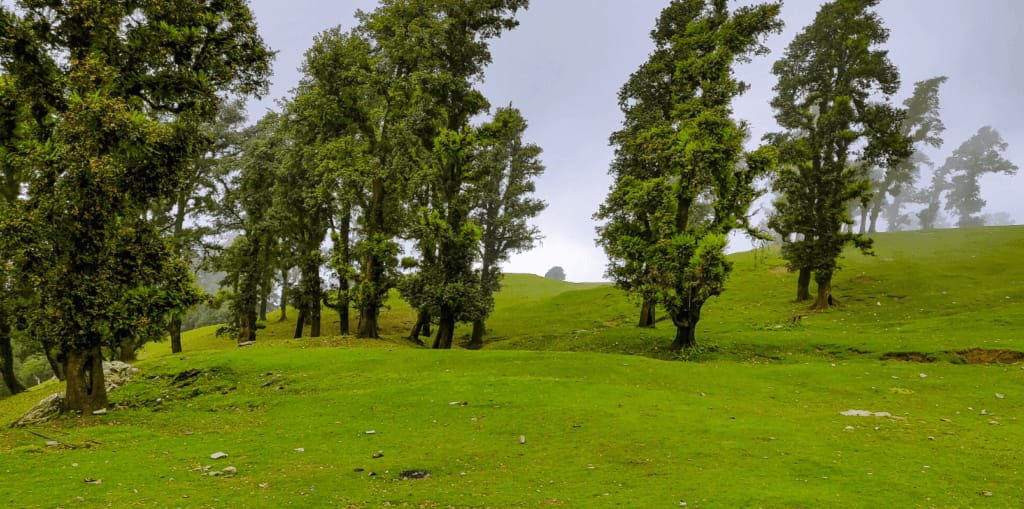
Tungnath is not an exclusive sightseeing locale. But it offers the most mesmerizing spiritual and adventurous experience to tourists. It is one of the ancient shrines snuggled amidst the picturesque backdrop that equals a picture postcard setting.
Pilgrimage- Out of the 5 PanchKedar shrines, Tungnath is the highest Shiva temple that holds deep reverence for Hindus. Pilgrims embarking on the Char Dham yatra usually visit Tungnath to seek blessings of Lord Shiva.
Trekking- The trekking route to Tungnath starts at Chopta. The trek of easy grade level takes you to the scintillating landscape of Garhwal Himalayas.
Birdwatching- The region in and around Tungnath, especially Chopta, is home to exotic species of birds. You can watch wild goat, Monal, Pika Mouse, and also musk deer, if lucky. The ideal months for bird watching are from February to April.
Enjoying nature- For nature lovers, the nearby Sari and Chopta villages, Deoria Tal, and spectacular Chandrashila summit offer a spellbinding vista and dreamy solitude.
The hushed hamlets of Sari and Chopta are the hidden gems of Uttarakhand. The sunrise view at Sari and Chopta is a once-in-a-lifetime experience. When the crimson rays of the sun paint the snow-laden mountains in hues of red and orange, the villages look paradisiacal.
Deoria Tal, the emerald water body set amidst the mammoth Chaukhamba peaks is a sparkling jewel that enamors tourists with its sheer beauty.
Chandrashila summit offers a spectacular 360 degrees view of the Garhwal Himalayas. Glimpses of Nanda Devi, Nanda Ghanti, Trishul, Dunagiri, Kamet, Thyalasagar, Chaukhambha, Kedar peak, and many Gangotri peaks mesmerize you with their imposing panorama from the top.
Frequently Asked Questions
How long is the Tungnath Trek?
Tungnath trek is only 5 km from Chopta. It is easily completed in 4 to 5 hours with frequent rests in between. Much of the time taken depends upon the physical and mental endurance of the trekker. Tungnath trek route is the shortest as compared to the other PanchKedar routes.
Is Tungnath Safe?

Tunganath is one of the safest trekking routes of the Uttarakhand region. However, one should avoid undertaking the Tungnath trek in the months of July and August. The region receives rainfall and is prone to landslides and road blockages. Tungnath is touted as a winter trek for adventure seekers and nature lovers. But winter months should be avoided if you don’t enjoy the cold weather. A point to note is that the wildlife in the Chopta region can be a little hostile. Therefore, tourists should not move around in the forest after dusk.
What is the difficulty level of Tungnath Trek?
The trek to Tungnath Temple takes you to an elevation of almost 12,000 feet above sea level. It is touted as a trek of moderately easy grade level. The trek journeys along with thick forests and expansive grasslands, and treats one with the breathtaking vista of snow drifted the Himalayas.
Is there snow in Tungnath trek?
In the winter months from December to early March, the temple of Tungnath is bedecked with a thick layer of snow. Snowfall is very common during this time of the year. The temperatures can go well below the freezing point. The air is crisp and the skies azure blue. If you are a winter buff who loves snow then winter is the season for you. It is recommended that you carry warm layered clothing to keep yourself comfortable. Trekking during these months is full of adventure but if you can take up the challenge then go for it.
In short, the Tungnath-Chandrashila peak trek is an upbeat mountain adventure soaked in spirituality and fun! This trek located in the heart of Uttarakhand makes for the most momentous excursions in the lap of nature. Just go for it!
04 Rudranath:
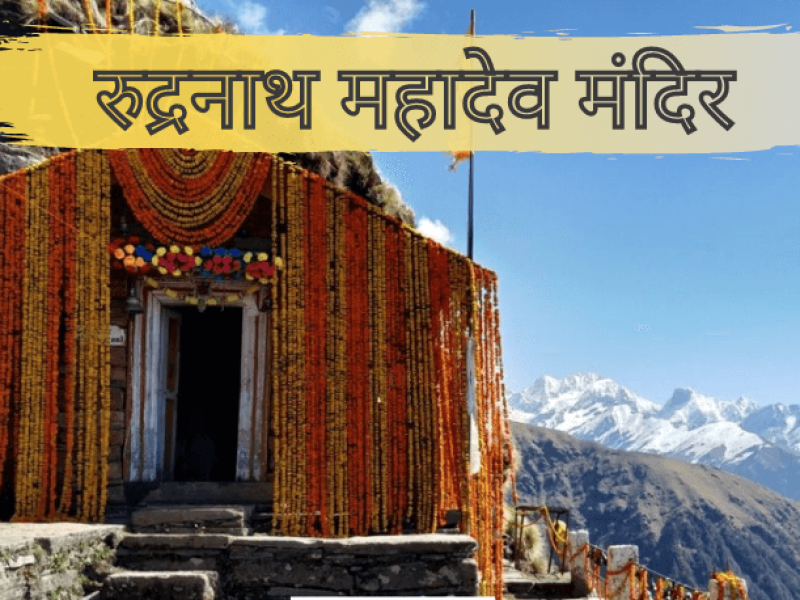
Toughest Kedar Rudranath is the highly revered temple of Lord Shiva is peacefully adorned in the Garhwal Himalayas. It is the fourth temple to visit in the circuit of Panch Kedar pilgrimage.
The celestial temple is snuggled inside the rhododendron forests and the alpine meadows. The exhilarating trek to Rudranath temple can be either commenced from Sagar village, Helang or Urgam village.
Rudranath temple is the toughest one to reach in comparison with other temples of Panch Kedar. The Himalayan peaks adding to the glory of Rudranath are Nanda Devi, Trishul and Nanda Ghunti.
The celestial temple is snuggled inside the rhododendron forests and the alpine meadows. The exhilarating trek to Rudranath temple can be either commenced from Sagar village, Helang or Urgam village.
Rudranath temple is the toughest one to reach in comparison with other temples of Panch Kedar. The Himalayan peaks adding to the glory of Rudranath are Nanda Devi, Trishul and Nanda Ghunti.
Rudranath trk The journey begins from Rishikesh from where you can take a taxi till Gopeshwar which lies in the way to Rudranath. Take rest at the Sagar village which lies at a distance of 5 km from Gopeshwar. The next morning is when the trek starts from a gate situated there. You will reach Pun Bugyal after 2 hours and have breakfast there. You will be required to climb uphill from here all through the forest.
As you keep moving up, you will notice a change in the atmosphere and nature at its best in here with mushrooms, flowers, and insects. You will then reach Litti Bugyal after 4-6 km. The next stop is Pun Bugyal which takes nearly 3 hours to reach. You can then set up tents here and relax for a while.The next morning you will start for the Rudranath Temple which is 8 km from Panar. After travelling for 2 hours, you will come across Pitradhar which is decorated with flags and bells. You will reach Naola Pass 1 km downhill from here where you can have your breakfast. You will finally be able to see the Rudranath Temple after 4 km surrounded by clouds.
Rudranath| Rudranath Trek Complete Travel Guide | Rudranath Trek | Rudranath Tourism | Rudranath Travel Guide | Uttrakhand Tourism
Rudranath
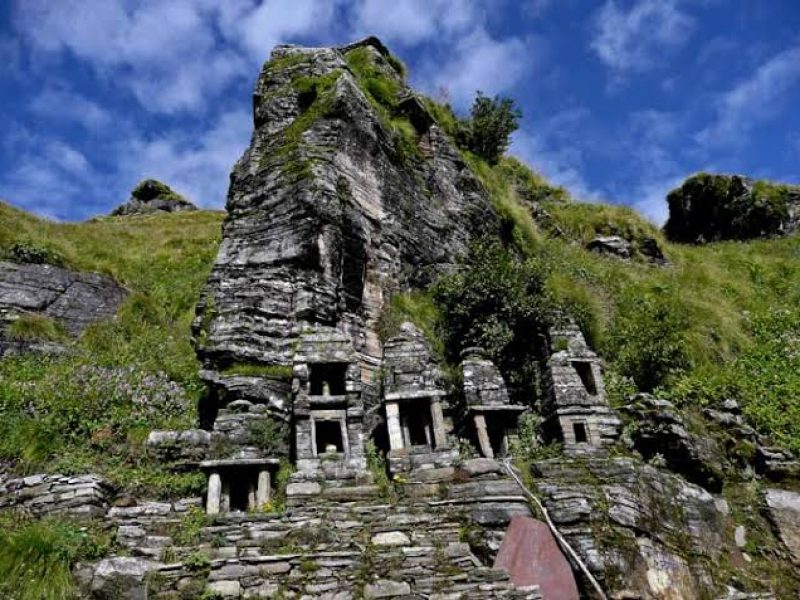
Among the Panch Kedar temples of Lord Shiva in Uttarakhand, Rudranath Temple is worshipped as the fourth Kedar. This ancient temple of Lord Shiva is located in the Rudraprayag district of Uttarakhand. Apart from Rudranath temple, other Panch Kedar temples of Lord Shiva worship Kedarnath as First Kedar, Madhyamaheshwar as Second Kedar, Tungnath as Third Kedar and Kalpeshwar as Fifth Kedar.
This temple of Lord Shiva is built in an ancient cave in which the face of Lord Shiva is worshipped. Due to the worship of the face of Lord Shiva here, that temple is called Rudranath. It is built amidst rhododendron and alpine meadows around the Shiva temple, which further enhances the natural beauty of this temple. Like the rest of the Kedar temples, the doors of the Rudranath temple are open only for six months a year.
(The Kalpeshwar temple is open for devotees throughout the year) The simple reason for this is that there are many snowfalls here in the winter season and for this reason, you can visit the Rudranath temple only for 06 months a year. The height of the Rudranath temple is only 2290 meters (7513 feet) above sea level, but out of all the Kedar temples, the most difficult and long walk is of this temple.
To reach the Rudranath Temple, you have to travel 20 kilometres (total 40 kilometres) on foot. You should have at least 4 – 5 days for the complete visit to Rudranath temple so that you can complete your walking tour of this temple without any hassle. Before starting the Rudranath temple walking tour or trek, there are some things that you should know before starting your journey to Rudranath like –
01 Where does the Rudranath Yatra start?
02 When does Rudranath Yatra start?
03 What to carry with you during the walking tour of Rudranath?
04 What facilities are available during Rudranath Yatra?
05 What are the precautions to be taken during the Rudranath Trek?
06 Travel route of Rudranath Trek?
So let us know what things we have to keep in mind during Rudranath Yatra.
Rudranath Trek
Situated in the Himalayan mountains, the Rudranath Temple is considered a moderate to difficult trek of 20 km long (total 40 km). Whenever you make an itinerary for Rudranath temple, make sure that you are physically fit and healthy. If you have respiratory or any other type of disease that causes difficulty in breathing, then you should not travel to Rudranath temple on foot.
The length of this trek and the steep steep climb make this trek even more difficult. During the trek to Rudranath temple, you reach the temple through alpine meadows, dense forests and deep valleys. And these dense forests and deep valleys make your Rudranath trek interesting and memorable.
The Rudranath trek is considered more difficult than all the other Kedar temple treks, but the more difficult this trek is, the more pleasure you get in completing this trek. From the Rudranath temple, there are very beautiful and eye-soothing views of the major mountain ranges of the Himalayas like Trishul, Nanda Devi and Nanda Ghunti etc. You are not provided with any kind of facility by the local administration during the Rudranath trek.
Yes, during the trek, there are some places on the way where you can rest for some time and you will also get the facility of breakfast and food. Apart from this, the residents have also made small eateries and restaurants during the trek, in which you can stay overnight by paying just some rent. Most of the facilities you get during the Rudranath trek are provided by the residents so that they can make your Rudranath Yatra easy and earn a living for your own family.
Three different treks are leading to the Rudranath temple. All these three treks present landscapes of different natural beauty. But most of the devotees and trekkers prefer to start their Rudranath trek from Sagar village. Now it depends on you how you want to trek Rudranath by road.
There is a very famous saying among the residents for Rudranath Trek, “The Ascent of Rudranath, Battle of the Germans”, you will know how true this saying is only when you do the Rudranath Trek.
Rudranath Temple Aarti Timings

The Prabhat Aarti in Rudranath Temple takes place at 08:00 in the morning and Sandhya Aarti at 06:30 in the evening. You should plan your trek in such a way that when you reach Rudranath after the trek, you can enjoy the evening aarti and the next day when you return from Rudranath, you can start your return trek by taking morning aarti.
Rudranath Temple opening date 2022
The doors of Rudranath temple will be opened for the general devotees on 19th May 2022, which will remain open for the devotees for the next six months.
Rudranath temple closing date 2022
So far no date has been fixed for the closure of the doors of the Rudranath temple. By the way, the doors of Rudranath temple are closed till the second week of November or even after Bhai Dooj, the doors of Rudranath temple are closed for the devotees.
Rudranath Trek Entry Fee
In Panch Kedar temples, no entry fee is charged for visiting the fourth Kedar Rudranath temple. But this temple is located in the area of Kedarnath Wildlife Sanctuary. Because of this, when you do the Rudranath trek and take any plastic packaging items with you such as water bottles, Maggi and biscuits etc.
Then the Forest Department will ask you for any plastic packaged items you have. Nos. charges Rs.100/-. In return for all the money you have deposited at the counter, you are given a slip, which you deposit at the forest department’s counter at the time of the return of your journey, then you get that money back.
But if you get less than one plastic packet out of the plastic packets you have written, then you can be fined Rs 5000/-. This decision on duty on plastic packets has been taken a while back so that plastic waste in forests and mountains is minimized.
Activities in Rudranath
Whenever you plan for the Rudranath trek and you have some spare time, you can also visit some ancient temples while doing the Rudranath trek. Apart from this, alpine meadows also come during the trek, which you can also take out. These grasslands are known as Luti Bugyal and Panar Bugyal.
Many mythological ponds like Chandra Kund, Manas Kund, Surya Kund and Tara Kund are also located around the Rudranath temple.
Rudranath Trek Route
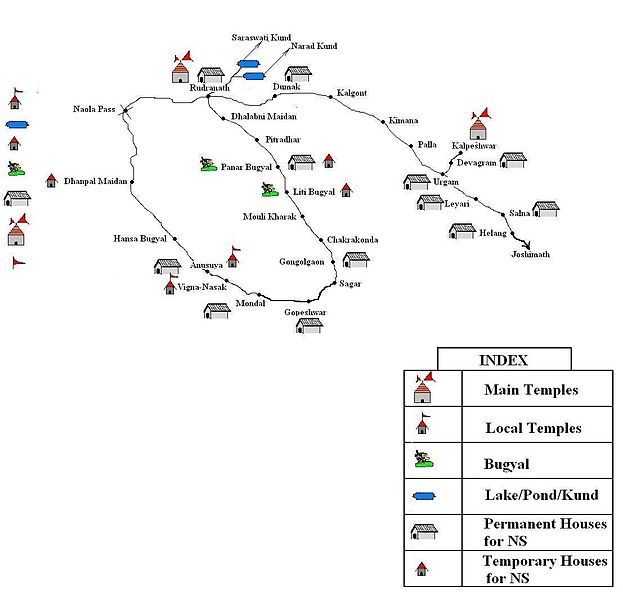
Rudranath Trek 01 – Sagar Village – Litti Bugyal – Panar Bugyal – Pitrudhar – Rudranath
Rudranath Trek 02 – Helang – Urgam – Kalpeshwar – Dumak – Bansi Narayan – Panar – Rudranath
Rudranath Trek 03 – Mandal Village – Anasuya Temple – Hansa Bugyal – Naula Pass – Rudranath
Rudranath Trekking Itinerary
By the way, it takes you 4-5 days to complete the Rudranath trek. Here it is the time of 4-5 days to complete the trek and not the time from starting the journey from your home to reaching back home. When you reach Rishikesh after starting your journey from your home and you reach back to your home from Rishikesh, this time will be considered as the additional time of your journey.
Therefore, you should also make the schedule of Rudranath Yatra in such a way that you do not face any kind of inconvenience related to time. I am going to tell you about the journey from Rishikesh to Rudranath here. Add extra to the time taken to reach Rishikesh from your home. Although there are 03 walks to Rudranath temple, among these three routes, the track from Sagar village to Rudranath is the most famous.
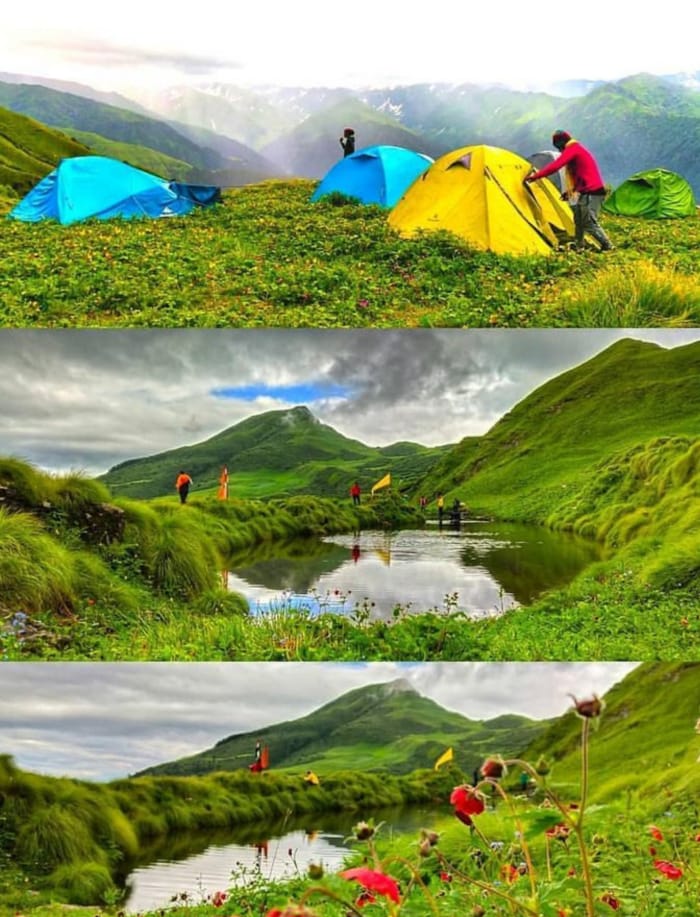
Day 1 –
Rishikesh to Sagar village (distance 215 km)
On the first day of your journey, you can reach Rishikesh by bus and taxi to Gopeshwar. From Gopeshwar you will get a taxi to reach Sagar. The distance of Sagar village from Gopeshwar is just 5 km. During the night you can stay at the homestay built-in Sagar village.
Day 2 –
Sagar-Pun Bugyal-Panar Bugyal (Total distance of the trek is 12 kms)
After resting overnight at Sagar village, you can start the trek the next morning at your convenience. When you start the trek from Sagar village, after trekking for about 02 hours, you reach Bugyal again, where you can rest for some time and have breakfast. After resting for some time in Pun Bugyal, you reach Luti Bugyal after trekking for about 4-6 km.
If you want, you can also enjoy food in Luti Bugyal. It may take another 3-4 hours to reach Panar Bugyal from Luti Bugyal. After reaching Panar Bugyal, you can stay in the homestay built here in the night time and if you have brought camping equipment then you can also do camping here.
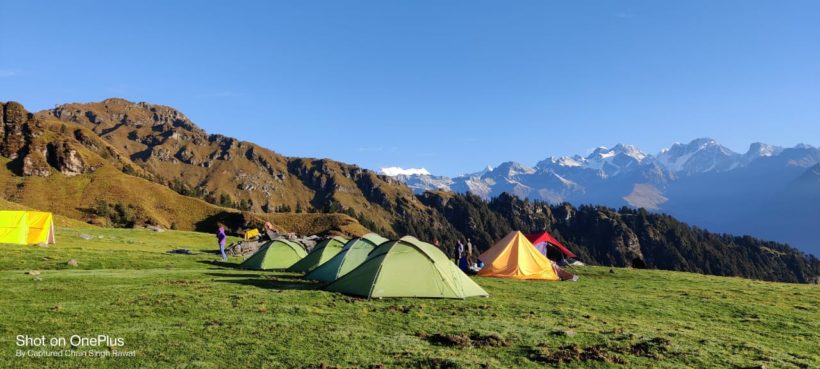
Day 3 –
Panar Bugyal – Rudranath (Total distance of the trek is 08 km)
From Panar Bugyal, you can wake up early in the morning and after having some breakfast, you can start the onward journey to Rudranath. After starting the trek from Panar Bugyal your next stop is Pitrudhar. It will take you a total of 02-03 hours to reach Pitridhar from Panar. You can relax for some time by reaching Naola Pass, located at a distance of 01 km from Pitridhar.
The total distance from Naola Pass to Rudranath Temple is 04 km. And this is also the last stop of your Rudranath Yatra. If you have reached Rudranath before Sandhya Aarti, then after Sandhya Aarti you can come back to Naola and go camping at night. But if you want to participate in Prabhat Aarti also, then you can stay in the accommodation built near the temple.
Note – Keep in mind that photography of any kind is not allowed inside the Rudranath temple.
Day 4 –
Rudranath to Sagar Gaon ( total trek distance of 20 km)
After seeing the Prabhat Aarti in Rudranath the next morning you can resume your journey to Sagar village. The more roads you cover today, the better. Otherwise, you can resume your journey to Sagar village early the next morning by stopping overnight at Luti Bugyal and Panar Bugyal.
Day 5 – Sagar village to Rishikesh
On the fifth day, after reaching Sagar village, you can travel to Rishikesh by bus and taxi via Gopeshwar.

Stay at Rundranath
There is no special arrangement made by the local administration for your stay or rest during the Rudranath trek. But during the trek, the facility of homestay is made available by the residents. In these homestays, you can stay comfortably in the nighttime by paying just a few rupees and apart from this, you also get the facility of local food here.
If you have camping equipment, you can also go camping in the alpine meadows during the night. If you are camping for the first time, then this activity also adds a different kind of memorable experience to your trip. An accommodation facility has also been provided for devotees and trekkers by the temple committee near the temple.
You will find the facility of homestay available in Sagar village, Luti Bugyal, Panar Bugyal and Urgam valley.
Food in Rudranath
During the Rudranath trek, you will find small eateries made by the residents at many places on the way where you can enjoy Maggi and local food. If you are travelling with your friends or with a trekking group, then you can also take your food items along with you.
You just have to make sure that if your food has any kind of plastic related packaging then you have to bring back all the plastic related items at the time of the return journey or else you may have to pay a very heavy fine.
Tips for Rudranath Trek
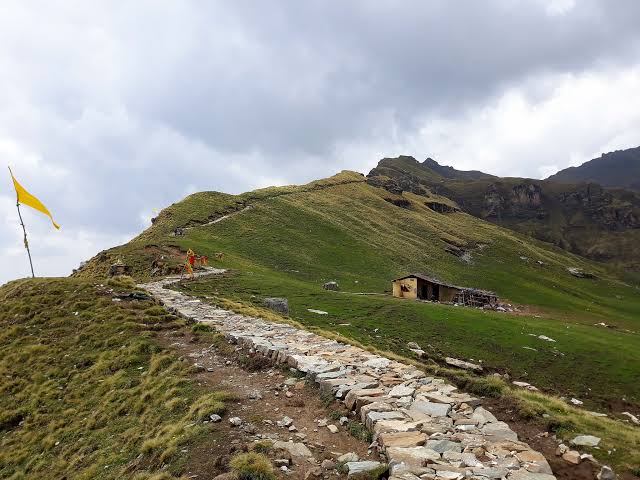
01 Identity Card
02 muffler
03 water bottles ( 3-5 litres)
04 Dry Fruits and Packet Food
05 Warm Clothes ( Sweater / Jacket / Pull Over )
06 Poncho / Rain Coat ( For Rainy Season )
07 Sunglasses
08 Extra Battery for Flashlight / Power Bank / Camera
09 Camping gear if possible. ( Mat / Sleeping Bag )
10 Waterproof bags to protect electronic items from rain.
11 lemon and salt or electrolyte powder/drink (Electrical/Gatorade/Glucon D)
12 Tracking Shoes / Tracking Paint / Quick Dry Tshirt / Cape
13 whistle (for emergency)
14 First Aid Kit:- Scissors, Sunscreen (SPF 50+), Band-Aids (Water Proof), Analgesic Spray (Relispray, Volini), Antiseptic Liquid (Sevlon, Dettol), Antiseptic Powder (Povidone-Iodine Based Powders like Cipladine, Savlon), bandage, cotton, crepe bandage etc.
15 medicines:- Fever, headache, motion sickness, loose motion, vomiting and acidity etc.
16 Must know about the weather before starting the Rudranath trek.
17 If you do not have experience in trekking in the mountains, then you can take a local guide with you.
(Note:- Before taking any kind of medicine, please consult your doctor.)
How to reach Rudranath
How to reach Rudranath by Air
Rudranath does not have any type of air service due to it being situated in the middle of the dense mountains of the Himalayas. The nearest airport to Rudranath is the Jolly Grant Airport of Dehradun. Dehradun is very well connected to major airports in the country.
The distance from Dehradun Airport to Rudranath (Gopeshwar) is 258 kilometres. To reach Rudranath, you have to reach Gopeshwar first. The 24-km trek to Rudranath starts from Sagar village, located at a distance of 05 km from Gopeshwar. From Dehradun, you will get a regular bus and taxi service to Gopeshwar.
From Gopeshwar you can start the track of Rudranath by reaching Sagar village.
How to reach Rudranath by Train
By the way, the nearest railway stations of Rudranath are Haridwar, Rishikesh and Dehradun railway stations. But the distance from Rishikesh railway station to Rudranath (Gopeshwar) is only 241 kilometres. From major cities of the country, you will get regular rail service to Rishikesh.
Bus and taxi services are available from Rishikesh to Gopeshwar regularly. From Sagar village, located at a distance of 05 km from Gopeshwar, you can start the track of Rudranath. Rudranath walk is 24 kilometres from Sagar village.
How to reach Rudranath by Road

Gopeshwar is very well connected by road with cities such as Haridwar, Rishikesh and Dehradun. Regular bus and taxi services are available from these three cities to Gopeshwar. If you are coming to Rudranath by your vehicle, then you can reach Sagar village located at a distance of 05 km from Gopeshwar with the help of your car. Rudranath’s walking tour starts from Sagar village itself.
(If you have reached here in this article, then I have a small request from you to share your suggestions related to this article in the comment box below, and if you see any deficiency or if you find any wrong information, then also definitely Tell me. I keep posting information related to travel on this website, if you like the information given by me, then you must subscribe to my website through my email, thank you)
naagisingh777@gmail.com/7060831895 website Ghoomouttarakhand.com
05 Kalpeshwar:
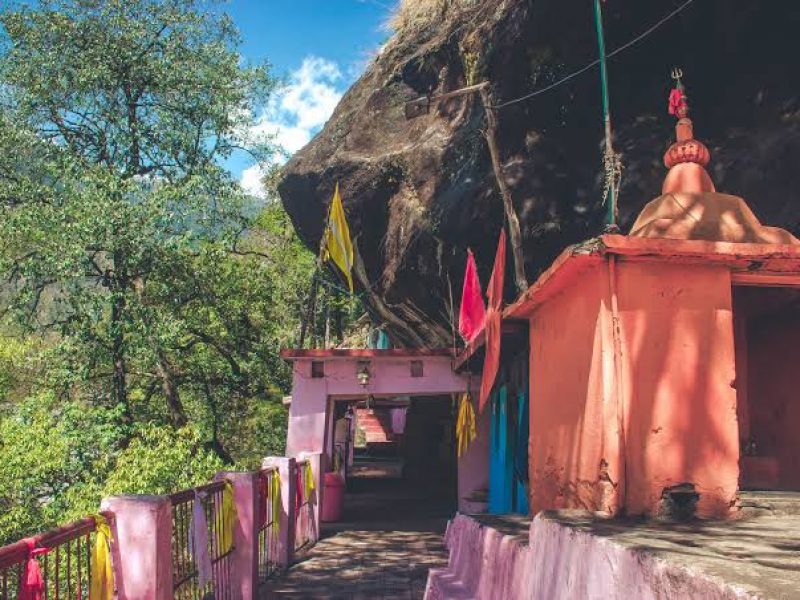
Kalpeshwar is the last and fifth temple in the list of Panch Kedar pilgrimage circuit and it is the only temple of the sacred Panch Kedars that remains open throughout the year. The matted hairs or Jata or Lord Shiva are worshipped inside this temple.
Lord Shiva is worshipped in the form of matted hairs at Kalpeshwar and the trail to this sacred shine goes through thick forests and lush green terrace fields. There is also an old Kalpvriksha tree here which is said to be the wish-granting tree in Hindu mythology Visitors need to trek only 2 km from Urgam to Kalpeshwar. This shrine is a delight for the tourists with striking views of valley with terraced fields and lush green forests. On the trek visitors can see Boodha Kedar temple, Dhyan Badri temple at Urgam village. Rudranath temple can be reached from kalpeshwar temple by trek.
Kalpeshwar temple is located at an height of 2200 mts, dedicated to Lord Shiva in the picturesque Urgam valley in the Garhwal region of Uttarakhand state in India. It is a part of the famous Panch Kedars.
At this small stone temple, approached through a cave passage, the matted tress (jata) of Lord Shiva is worshipped. Hence, Lord Shiva is also called as Jatadhar or Jateshwar. It is approachable only by 12 km trekking from the nearest road head of Helong on the Rishikesh-Badrinath road.
Kalpeshwar History and Legend
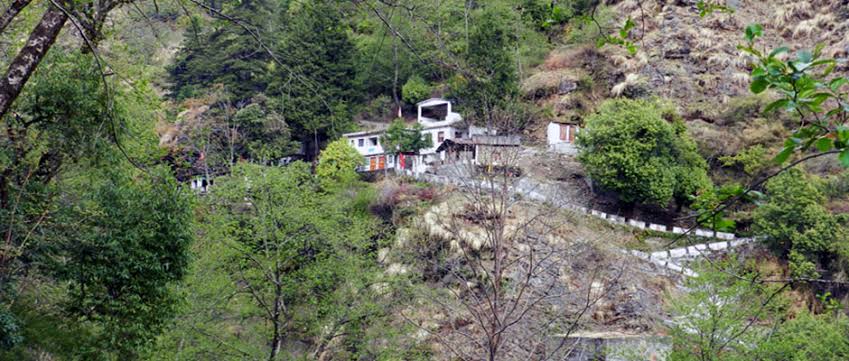
Kalpeshwar temple legend linked to the Pandavas, heroes of epic Mahabharata eminence is the fifth temple of the Panch Kedars (five temples) of Shiva’s five anatomical divine forms; the other four temples in the order of their worship are Kedarnath, Rudranath, Tungnath and Madhyamaheshwar temples.
The epic legend narrated on the creation of the Panch Kedar temples is that Pandavas of Mahabharata epic history, while chasing Lord Shiva to seek his pardon for the fratricidal sins committed by them during the Kurukshetra war, realized that Shiva, in order to distance himself from the Pandavas, took the incognito form of a bull. But when this form of Shiva was discerned by Bhima, the second of the Pandava brothers, tried to hold on to the bull’s tail and hind legs. But the bull vanished underground at Guptakashi. Subsequently it reappeared in five different forms: His hump appeared at Kedarnath, his bahu (arm) was spotted at Tungnath, his head surfaced at Rudranath, the stomach and navel were traced at Madhyamaheswar and his jata (tress) was divined at Kalpeshwar.
Another legend states that this place was much preferred by sages of folklore for meditation. Particular mention is made of sage Arghya who through his austere penance created Urvashi, the famous apsara (nymph) at this place. Durvasa, an ancient sage, son of Atri and Anasuya, considered an incarnation of Shiva, known for his short temper did penance and meditated under the Kalpavriksha, the wish fulfilling divine tree in the precincts of the temple.
Pooja in Kalpeshwar Temple
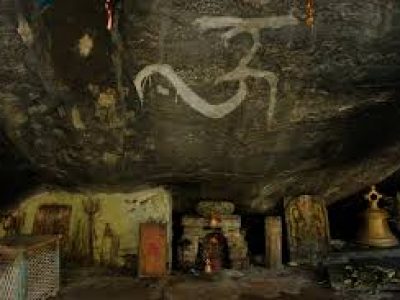
The temple priests at this temple also are the Dasnamis and Gossains, desciples of Adi Shankara, hail from South India. The Namboodiri brahmin sect who worship at Badrinath and Kedarnath from Kerala, the Jangamas are lingayats from Mysore and the Dasnami Gossains belong to Adi Shankara’s group.
Kalpeshwar Opening and Closing Timings
Kalpeshwar is the only Panch Kedar temple accessible and open throughout the year. All other Kedar are closed during winters.
Kalpeshwar as Trekking Destination
This temple is located in Urgam valley. This shrine is a delight for the tourists with striking views of valley with terraced fields and lush green forests. The temple is reached after a trek of 12 km from Helang which is the motor head on Rishikesh – Badarinath route. Trekking in this rocky terrain is a favorite where the trekkers are provided with the some of the hardest trekking routes.
Best Time to Visit Kalpeshwar
Best Months: May, June, September, October
Kalpeshwar in Summers (April to August): are very pleasant with moderate climate, with average around 15°C. Summers is ideal for all sight seeing, temple visit and also for visiting nearby attractions.
Kalpeshwar in Monsoons (September to November): are accompanied with scanty rains. This period is good for sight seeing as the hilly panoramic views are very attractive in rains.
Kalpeshwar in Winters (December to March): are chilly days with average minimum touching near 4°C. Minimum can touch sub zero levels.
How To Reach Kalpeshwar
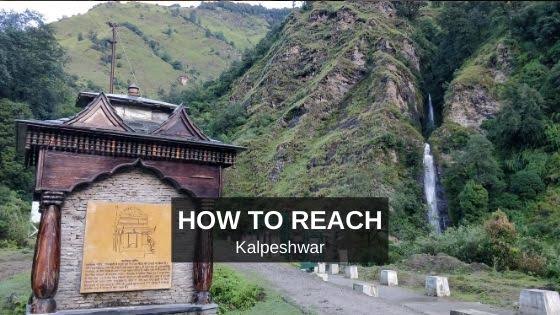
By Road: Kalpeshwar can be reashed up to Helang, 243 kms. on the Rishikesh – Badrinath road by bus and taxis. From Helang, the 12 kms. trek is off the main road.
Boodha Kedar temple surrounded by potato fields is seen on the trek route. Also seen is the Dhyan Badri temple at Urgam Village, one of the Sapt Badri (seven Badri) temples.
By Air: Nearest airport is Jolly Grant, Dehradun 272 kms
By Rail: The nearest railhead, Rishikesh is 255 kms
What is the motorable route?

Haridwar – Rishikesh – Devprayag – Srinagar – Rudraprayag – Karnaprayag – Nandprayag – Chamoli – Pipalkoti – Helang – Lyari – Devgram
Total Distance – 275 kilometres, approximately
Earlier, the trek to Kalpeshwar started from Lyari as the road till Devgram was still under construction. Now, I’m told, the road has been completed although it’s not a firm one and not always open.
The road from Haridwar to Helang is more or less well-maintained except for a few patches that fall under the landslide zone.
But it is not going to be a cakewalk driving from Helang to Devgram. It is not a road but a trail of loose (mostly) soil and rocks that is prone to breaking apart. It is advised that you keep driving till Joshimath (14 kilometres from Helang), park your vehicle there and then take a shared jeep to Devgram via Helang. Unless you are a pro at off-roading!
This more than sorts it out in case you are driving your own vehicle or a self-drive vehicle.
In case I want to opt for public transport?
Take a bus or shared taxi (Max) from Haridwar/Rishikesh to Joshimath
Get down at Helang and take a shared taxi (Max) to Lyari/Devgram
Please note that almost all of the taxis to Devgram ply from Joshimath and aren’t as frequent as to other popular places. You might have to wait it out at Helang. Alternatively, you can get down at Joshimath and stay there for the night. Next morning, take a shared taxi from Joshimath to Devgram. If you don’t like to wait it out and have money to spare, you can book the entire vehicle (from Joshimath) at around INR 500-600 for one way.
Buses, both local and of Uttarakhand State Transport, and shared taxis start plying from Haridwar/Rishikesh to Rudraprayag and further as early as 4 am.
Please note that almost all of the taxis to Devgram ply from Joshimath and aren’t as frequent as to other popular places. You might have to wait it out at Helang. Alternatively, you can get down at Joshimath and stay there for the night. Next morning, take a shared taxi from Joshimath to Devgram. If you don’t like to wait it out and have money to spare, you can book the entire vehicle (from Joshimath) at around INR 500-600 for one way.
Buses, both local and of Uttarakhand State Transport, and shared taxis start plying from Haridwar/Rishikesh to Rudraprayag and further as early as 4 am.
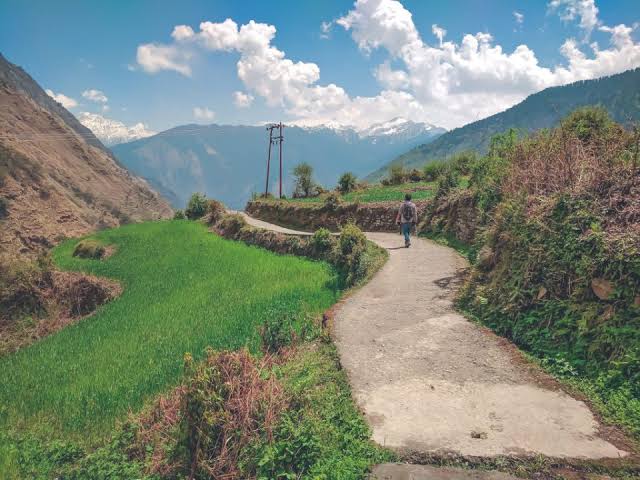
How long is the trek? How is the trek route like? Do I need a guide?
The trek from Lyari to Kalpeshwar is barely 2 km, whereas from Devgram to Kalpeshwar it is less than 500 m and pretty straight forward, passing through the gorgeous Urgam Valley. Most of the route is paved with little to no ascent. Reach till the end of the village, a curve from where the path descends towards the river. You will see a short ascent on the other side of the river, left to the waterfall, and leading up to Kalpeshwar temple, neatly hidden between the rocks. Walk down and take the little wooden bridge to reach to the other side.
If you start early, you can make it back to Joshimath by afternoon quite easily.
You do not need a guide.
Where to stay and how much will it cost?
There are a decent number of guest houses and lodges in Devgram where you can get a room for about INR 300-400 for two. The vibe here is inherently different than rest of the four Kedar combined. Even though the trek is short-lived, Urgam Valley makes it up with its chilled-out demeanour and ever-so-smiling locals.
If you wish to come back to Joshimath the same day, there are plenty of options, the cheapest one being the dormitory beds at GMVN, available for INR 300 per person. And if budget is not a constraint, you can also go for luxury cottages, and a few small guest houses and resorts at Auli, 25 km from Devgram.
This is the gist of it. If you have any further queries, feel free to leave a comment below. I’ll get back to you as soon as I can. Stay safe, travel responsibly!
EugeneRhipt
Полностью актуальные новости индустрии.